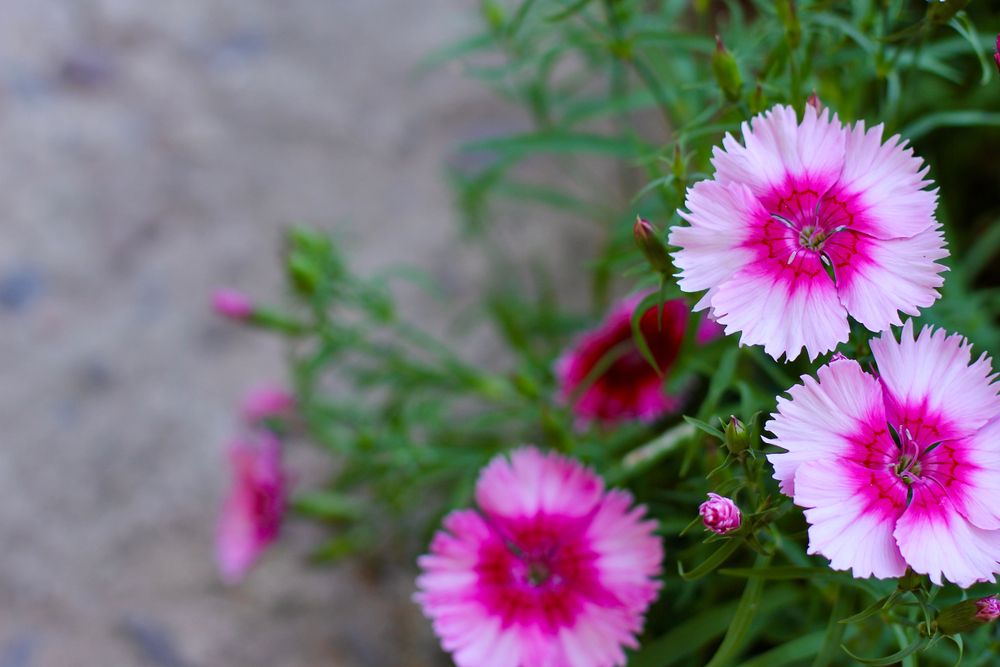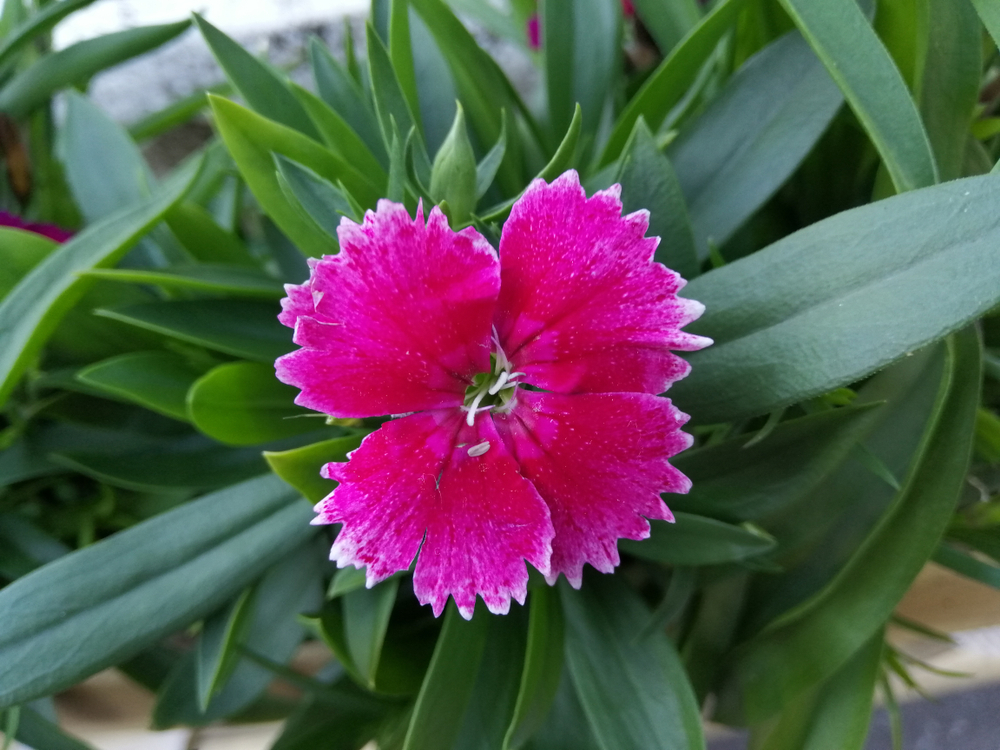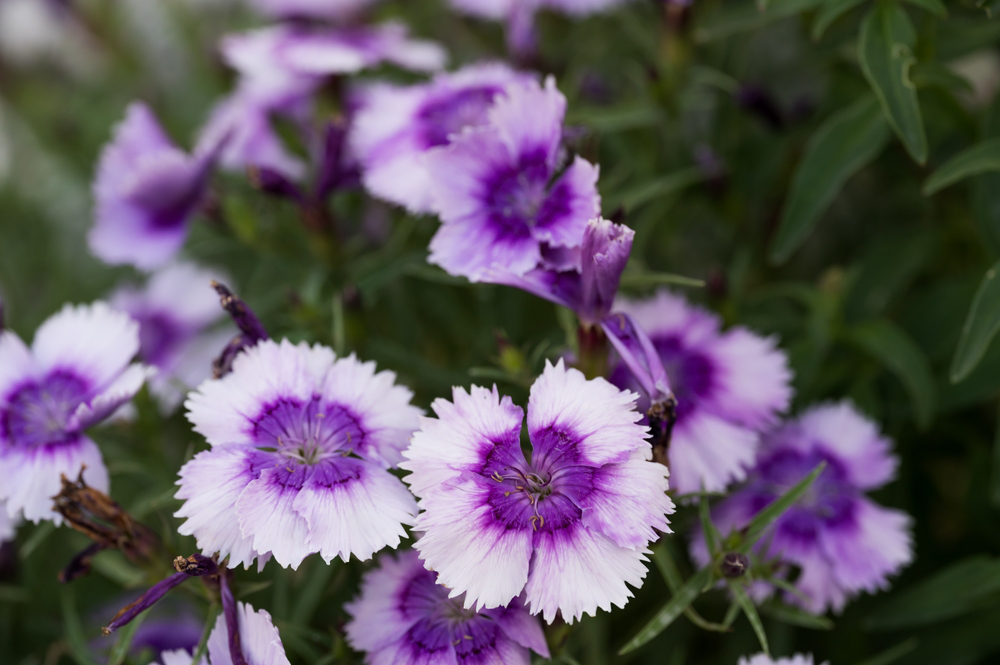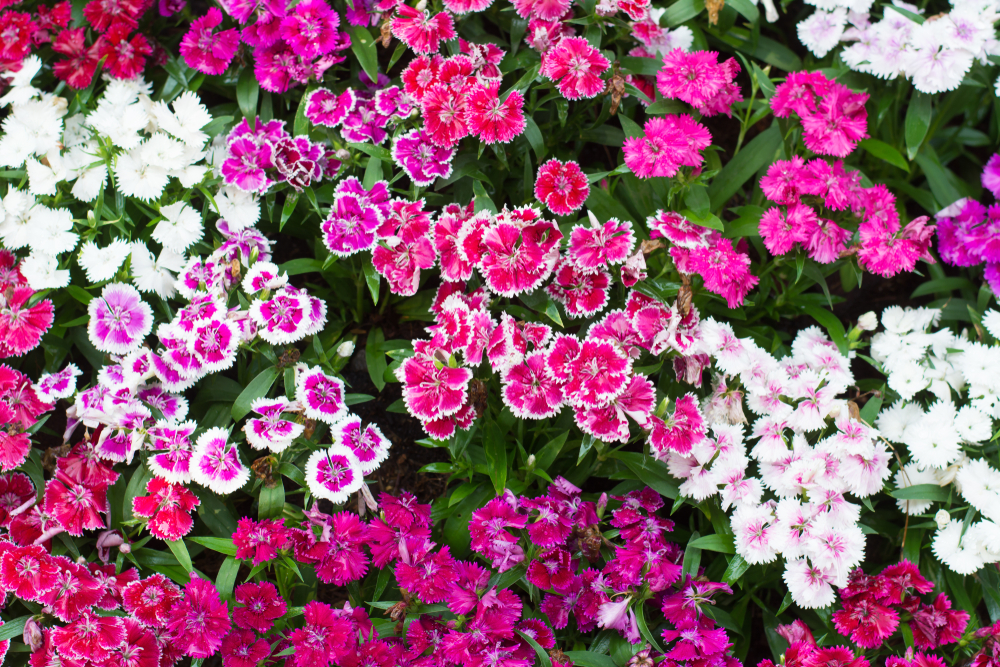The Dianthus flower, often affectionately called “pinks,” is a delightful and adaptable plant that showcases vibrant blooms, frilly petals, and a lovely clove-like scent. You can find Dianthus flowers in a rainbow of colors, including pink, red, white, and purple. The name Dianthus is derived from the Greek words dios (meaning god) and anthos (meaning flower), which together translate to “divine flower.”
This charming plant is part of the Caryophyllaceae family and boasts hundreds of species and hybrids. Originally hailing from Europe and Asia, Dianthus is a resilient plant flourishes in full sunlight and well-drained soil. It’s easy to care for and attracts pollinators, making it a wonderful addition that brings beauty, fragrance, and timeless elegance to any outdoor space.
Dianthus comes in a variety of types, such as Dianthus chinensis (Chinese pinks), Dianthus caryophyllus (carnations), and Dianthus barbatus (Sweet William). Each type showcases its unique bloom style and color palette, ranging from gentle whites and soft pinks to vibrant magentas and rich purples. These charming plants are particularly loved for home gardens, balconies, and containers because of their compact growth and their knack for producing beautiful blooms over a long period.

Dianthus Flower Plant – Quick Facts
| Particulars | Description |
| Scientific name | Dianthus spp. |
| Other names | Pinks, Sweet William, Carnation |
| The Indian name of Dianthus | Not widely known by a specific Indian name, commonly called “Dianthus” |
| Native | Europe and Asia |
| Best season to plant Dianthus | Early spring or fall is ideal for planting |
| Bloom season | Spring to fall |
| Height of the plant | Grows between 4 to 36 inches (variety dependent) |
| Width of the plant | 4 to 24 inches |
| Water requirement | Moderate watering, about 1-2 times per week, depending on the climate |
| Light requirement | Prefers full sunlight (at least 4-6 hours daily) |
| Soil | Well-draining soil with a slightly alkaline to neutral pH (6.5-7.5) |
» Also Read: Passiflora Caerulea: Tips for Growth and Care at your Home
Dianthus is one of the most popular flowering plants known for its vibrant colors and delicate fragrance. It is a compact, bushy plant that grows well in borders, pots, and garden beds. The plant forms neat mounds of slender green leaves, from which clusters of flowers bloom beautifully. The flowers typically measure 3–5 cm in diameter and are known for their finely fringed or serrated petals, giving them a soft, ruffled appearance. While it does not produce fruit like some flowering vines, its long-lasting blooms and pleasant scent make it a favorite for ornamental gardening and floral arrangements.
The Miniature Dianthus Flower Plant
As the name suggests, the Miniature Dianthus is a smaller version of the classic Dianthus plant. Its delicate blooms typically measure around 2–3 cm in diameter.
Dianthus Flower in Hindi
The Hindi name for the Dianthus flower is commonly called Dianthus itself, as it does not have a widely recognized traditional Hindi name. However, it is sometimes loosely called “Gulabi Phool” or “Sundar Phool” due to its vibrant pink hues and attractive appearance.
How to Grow Dianthus Flower Plant
The Dianthus flower plant is truly a stunning addition to any garden. With its soft, frilly petals and delightful clove-like fragrance, it’s no wonder garden enthusiasts adore it. Whether you choose to plant it in pots, along borders, or in flower beds, Dianthus brings a lovely splash of color and charm to your outdoor area. Originally hailing from Europe and Asia, it thrives beautifully in Indian climates as well. With just a bit of care, you can enjoy its vibrant blooms from spring through fall. Here are some handy tips to help you grow and nurture the Dianthus flower plant in your home garden.
1. Get Quality Seeds or Saplings
Choose high-quality Dianthus seeds or healthy nursery saplings. There are annual, biennial, and perennial varieties, so pick one that suits your garden needs and climate.
2. Prepare the Right Soil
Use well-drained, slightly alkaline soil enriched with compost. A mix of garden soil, sand, and organic manure ensures healthy root growth and prevents waterlogging.
3. Sow and Provide Sunlight
Scatter seeds on the surface without burying them deep. Dianthus seeds need light to germinate. Keep the soil moist and place the container in a sunny area that receives at least 4-6 hours of sunlight daily.
4. Transplant After Germination:
Once seedlings develop 3-4 true leaves, transplant them into larger pots or garden beds. Maintain a spacing of 6-8 inches to allow for airflow and proper growth.
5. Water and Maintain
Water the plants moderately, once or twice a week. Deadhead faded blooms regularly to promote continuous flowering. Apply mild organic fertilizer every 3-4 weeks for vibrant, long-lasting blooms.

How to Care for the Dianthus Flower Plant
Dianthus is a low-maintenance, colorful plant that blooms beautifully when given the right care. Follow these simple tips to keep your Dianthus healthy and blooming for a long time:
1. Sunlight: Dianthus loves sunlight. Make sure it gets at least 4-6 hours of direct sun daily. It can tolerate partial shade but blooms best in full sun.
2. Watering: Water the plant once or twice a week, depending on the weather. Let the soil dry slightly between waterings. Avoid overwatering, as Dianthus does not like soggy soil.
3. Soil: Use well-drained, slightly alkaline soil. You can mix garden soil with compost and sand to improve drainage and soil health.
4. Deadheading: Remove dried or faded flowers regularly. This helps the plant focus its energy on producing new blooms and keeps it looking neat.
5. Fertilizer: Feed your Dianthus every 3-4 weeks during the growing season with a mild organic or balanced liquid fertilizer to encourage more flowers.
6. Pest Control: Look for aphids or spider mites. If needed, spray neem oil or a gentle insecticidal soap to protect the plant.
Vastu Tips for Dianthus Flower Plant
According to Vastu principles, a Dianthus flower plant should be placed in the north, east, or northeast direction to attract positivity and harmony. Avoid planting it in the south or southwest areas. Growing Dianthus near windows, balconies, or entrance areas can enhance the home’s beauty while attracting peace and prosperity.
»Also Read: Vastu Remedies for Peace at Home
Benefits of Dianthus Flower Plant
The Dianthus flower is not only pretty but also known for some traditional health uses.
In old herbal medicine, parts of the Dianthus plant were used to help with urine problems and to clean the body by acting as a natural cleanser. It was also used on the skin to help heal cuts, rashes, and minor infections due to its gentle antibacterial effects.
In Chinese medicine, Dianthus is used to help with digestion, reduce swelling from water retention, and improve blood flow. Some people even make tea from its parts to help cool the body and remove toxins. Its sweet, clove-like smell is believed to lift mood and reduce stress, which is why it’s also used in natural scent therapies.

Pests That the Dianthus Flower Plant Attracts
1. Aphids: Tiny insects that feed on plant sap often cause leaf curling and leave behind a sticky substance that can attract other pests or lead to mold growth.
2. Spider Mites: Minuscule pests that leave behind delicate webbing and speckled leaf surfaces. They sap the plant’s strength and spoil its appearance.
3. Thrips: Slender-bodied bugs that feed on plant cells, leading to silvery streaks, misshapen leaves, and distorted flowers.
4. Whiteflies: These small, winged insects hover around leaves, sucking out nutrients. Infestations often result in yellowing foliage and a sticky residue that can promote fungal growth.
5. Ants: Often drawn to the sugary secretions or nectar of Dianthus flowers, ants may chew on the petals, leading to early flower drop.
6. Caterpillars: Larvae of moths or butterflies attracted to the plant may chew holes in the leaves or flowers, stunting plant growth.
Dianthus, with its vibrant colors, sweet clove-like fragrance, and easy care routine, is a perfect addition to any garden or balcony. Its long blooming season, compact growth, and ability to attract pollinators make it both beautiful and beneficial. With just a little sunlight, moderate watering, and basic maintenance, Dianthus rewards gardeners with cheerful blooms from spring to fall. Whether grown in pots or beds, it brings color, charm, and a touch of elegance to any space.










